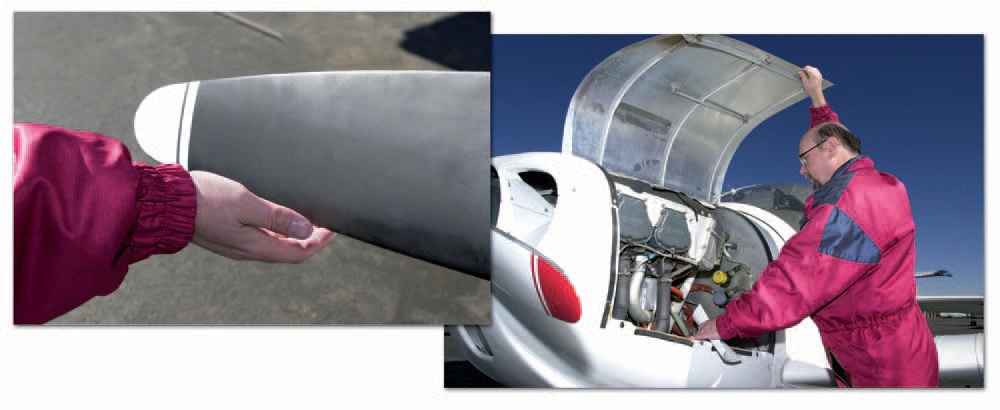
Chapter 2—Ground Operations
Table of Contents
Visual Inspection
Inside the Cockpit
Outer Wing Surfaces and Tail Section
Fuel and Oil
Landing Gear, Tires, and Brakes
Engine and Propeller
Cockpit Management
Ground Operations
Engine Starting
Hand Propping
Taxiing
Before Takeoff Check
After Landing
Clear of Runway
Parking
Engine Shutdown
Postflight
Securing and Servicing

ENGINE AND PROPELLER
The pilot should make note of the condition of the engine cowling. [Figure 2-8] If the cowling rivet heads reveal aluminum oxide residue, and chipped paint surrounding and radiating away from the cowling rivet heads, it is a sign that the rivets have been rotating until the holes have been elongated. If allowed to continue, the cowling may eventually separate from the airplane in flight.

Figure 2-8. Check the propeller and inside the cowling.
Certain engine/propeller combinations require installation of a prop spinner for proper engine cooling. In these cases, the engine should not be operated unless the spinner is present and properly installed. The pilot should inspect the propeller spinner and spinner mounting plate for security of attachment, any signs of chafing of propeller blades, and defects such as cracking. A cracked spinner is unairworthy.
The propeller should be checked for nicks, cracks, pitting, corrosion, and security. The propeller hub should be checked for oil leaks, and the alternator/ generator drive belt should be checked for proper tension and signs of wear.
When inspecting inside the cowling, the pilot should look for signs of fuel dye which may indicate a fuel leak. The pilot should check for oil leaks, deterioration of oil lines, and to make certain that the oil cap, filter, oil cooler and drain plug are secure. The exhaust system should be checked for white stains caused by exhaust leaks at the cylinder head or cracks in the stacks. The heat muffs should also be checked for general condition and signs of cracks or leaks.
The air filter should be checked for condition and secure fit, as well as hydraulic lines for deterioration and/or leaks. The pilot should also check for loose or foreign objects inside the cowling such as bird nests, shop rags, and/or tools. All visible wires and lines should be checked for security and condition. And lastly, when the cowling is closed, the cowling fasteners should be checked for security.
PED Publication